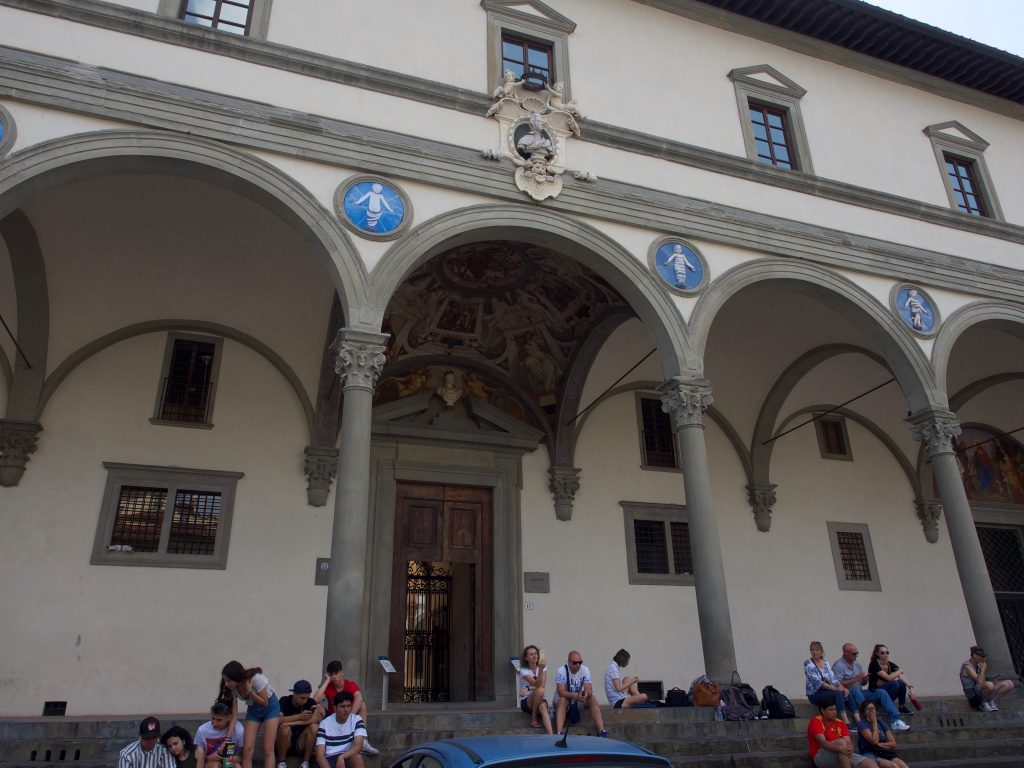
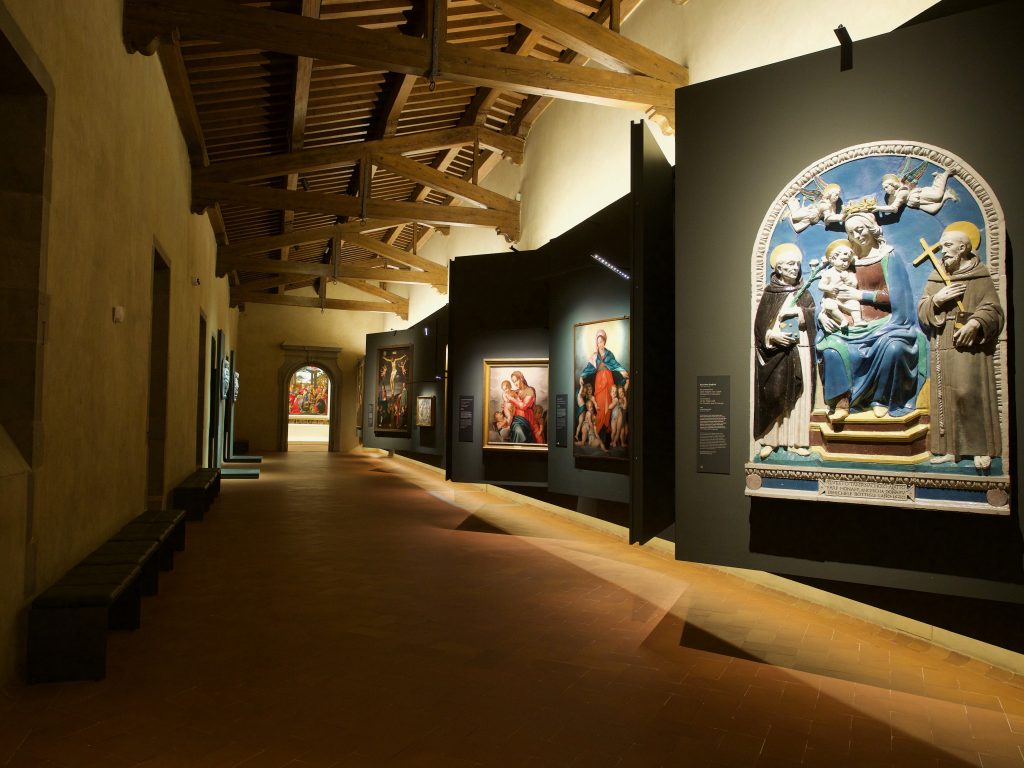
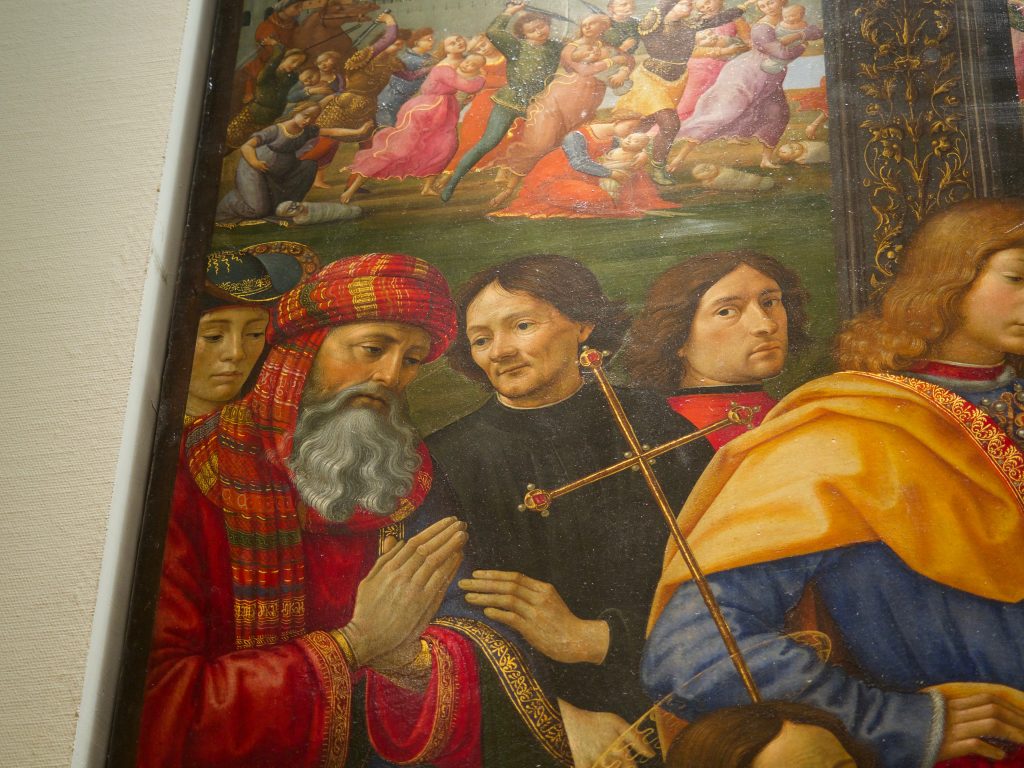
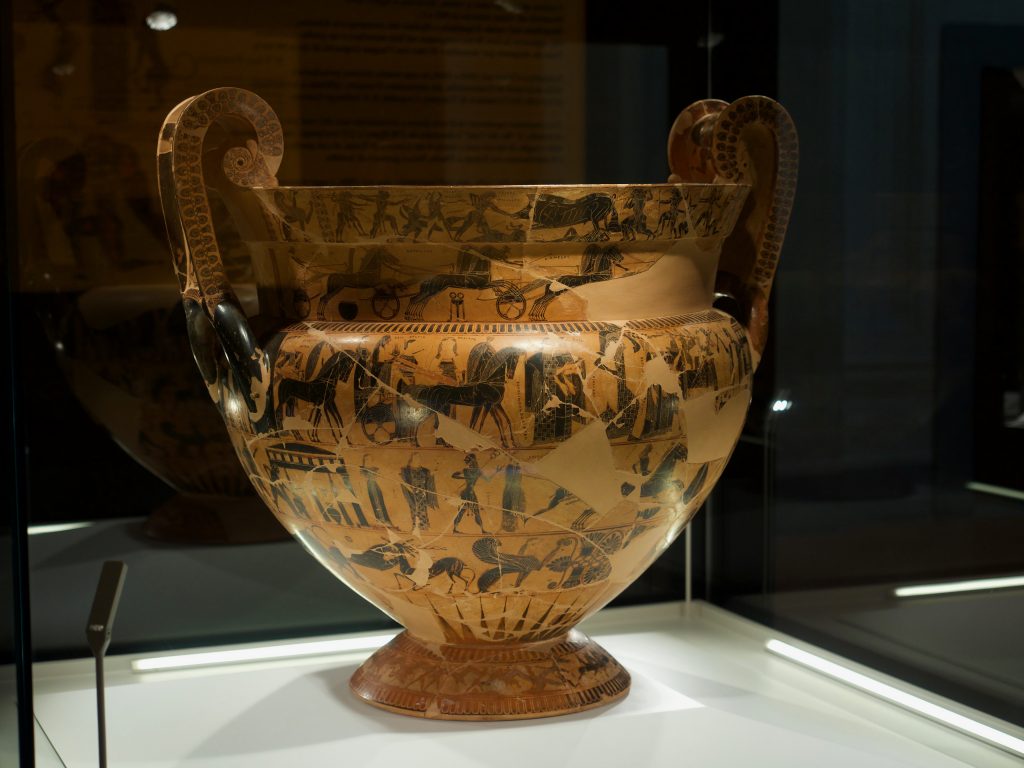
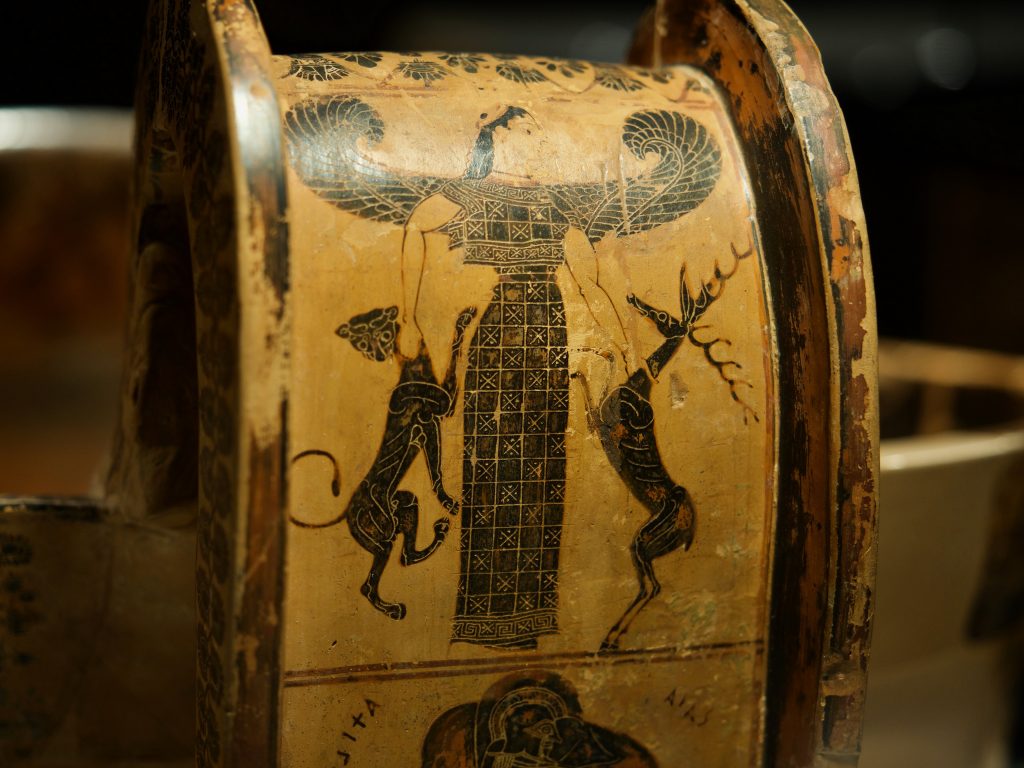
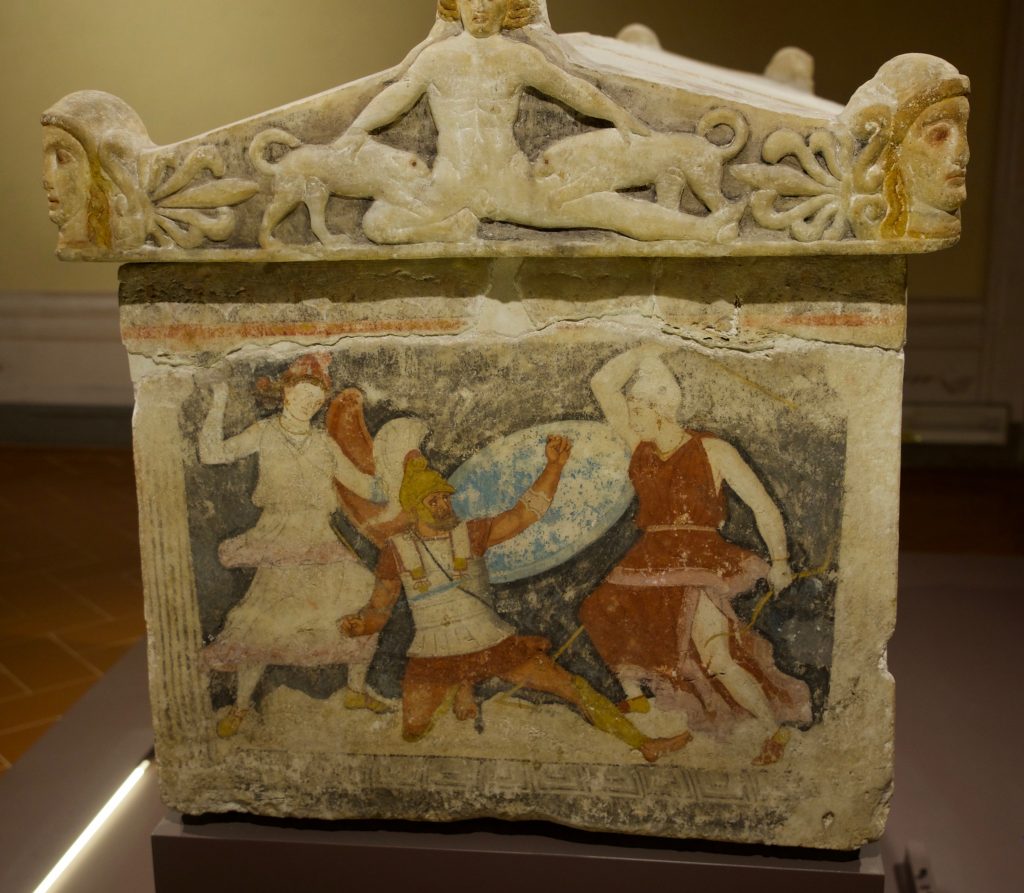
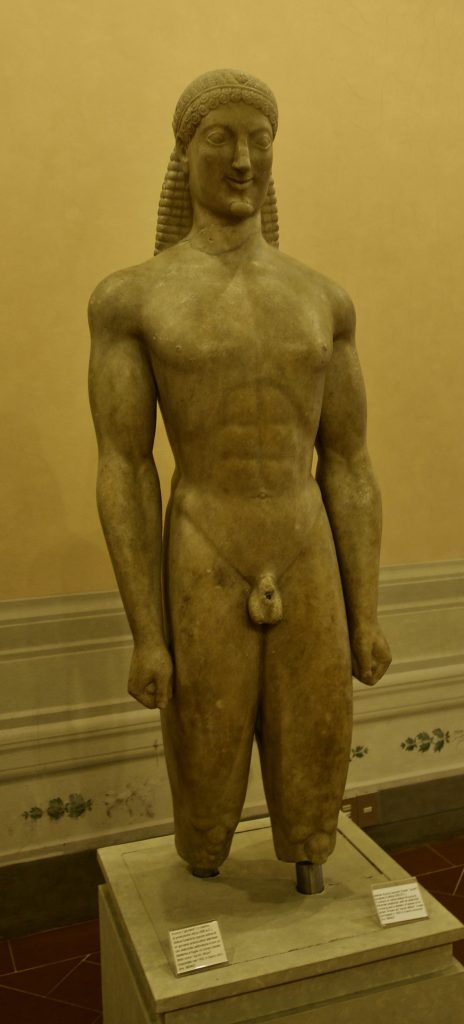
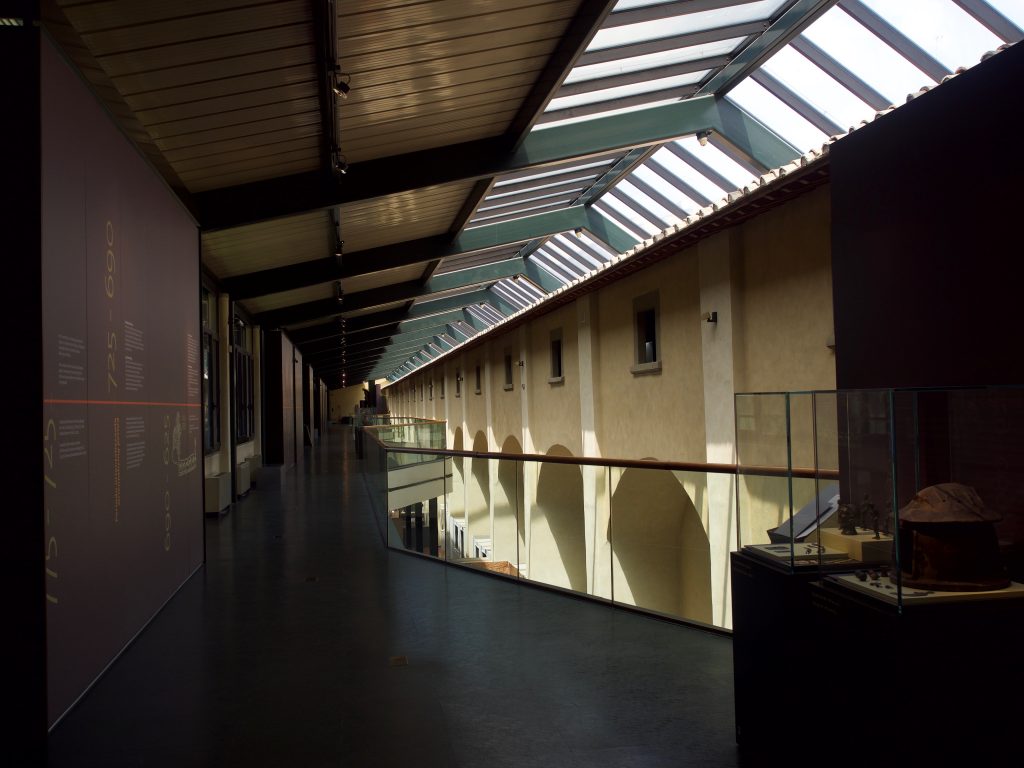
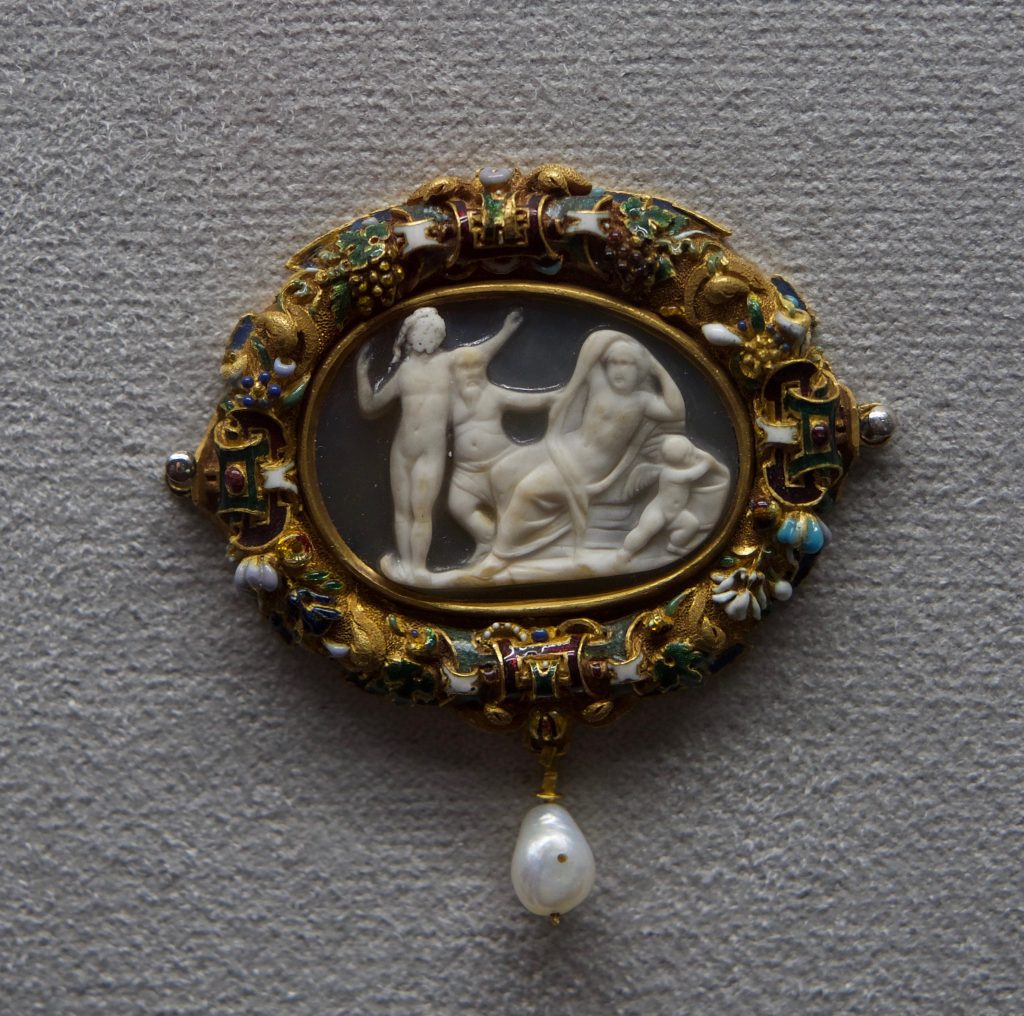
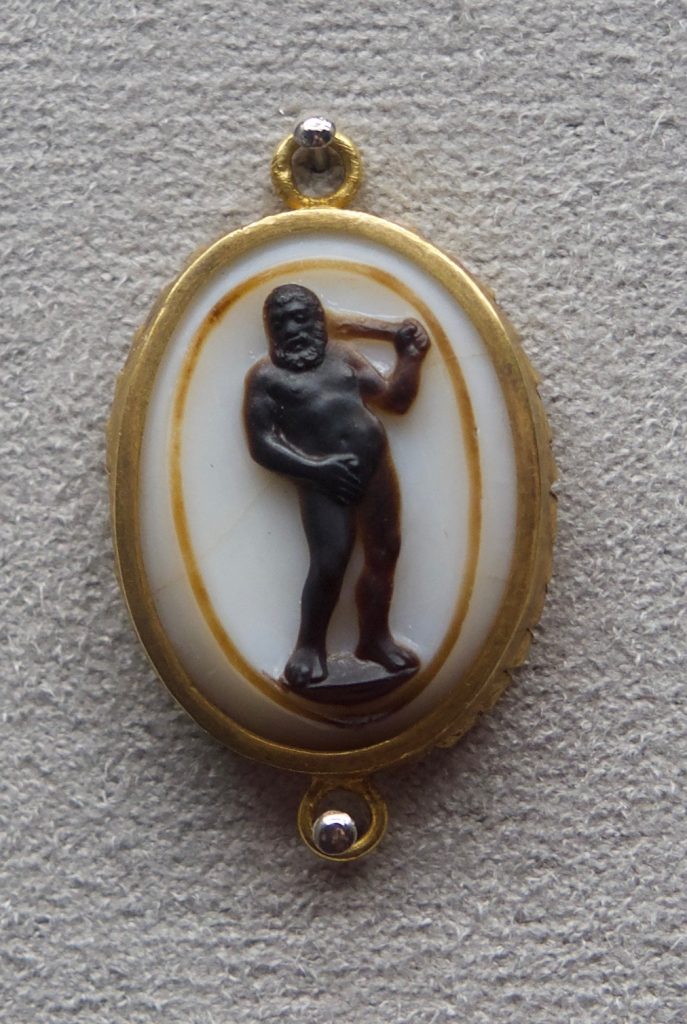
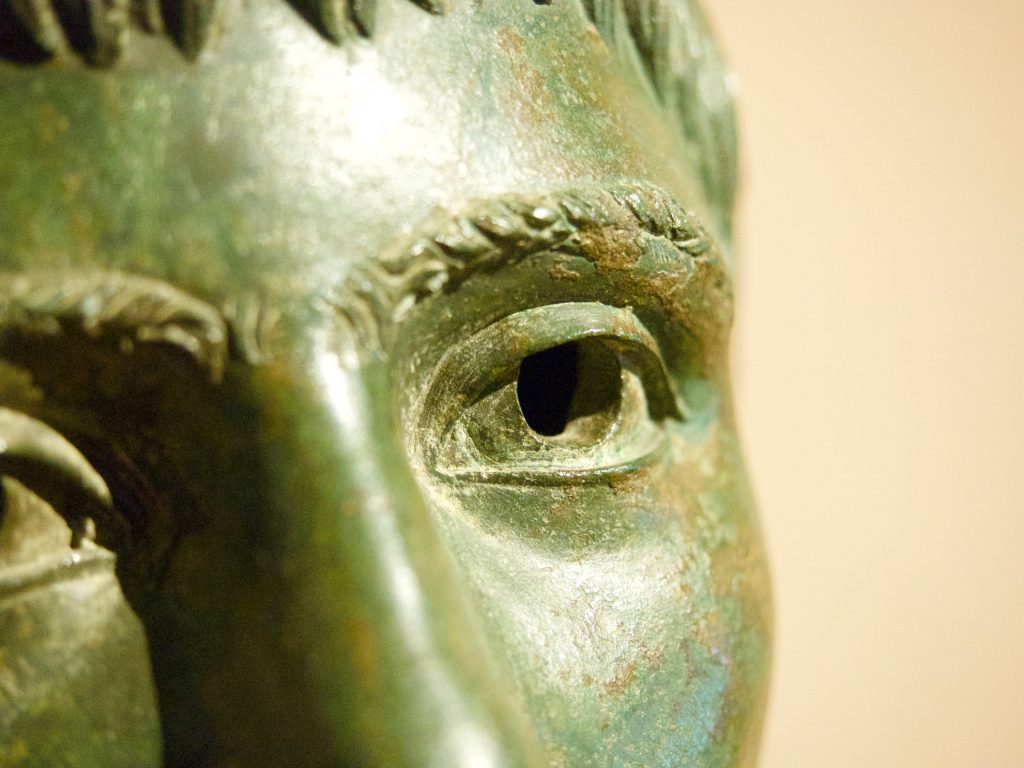
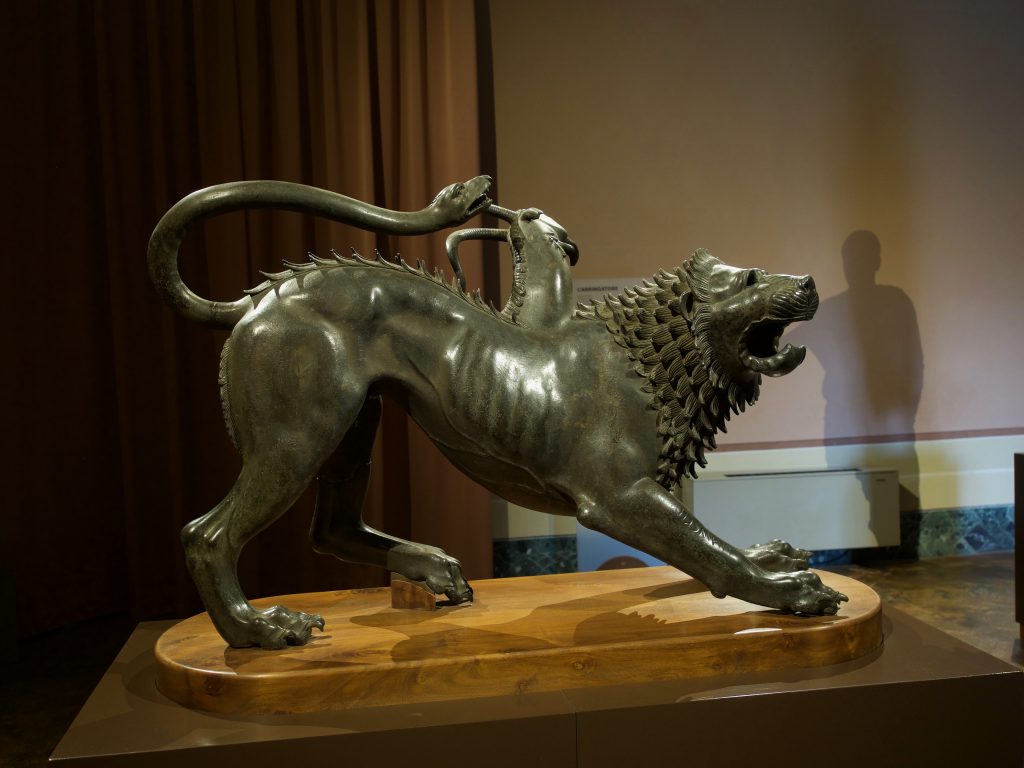
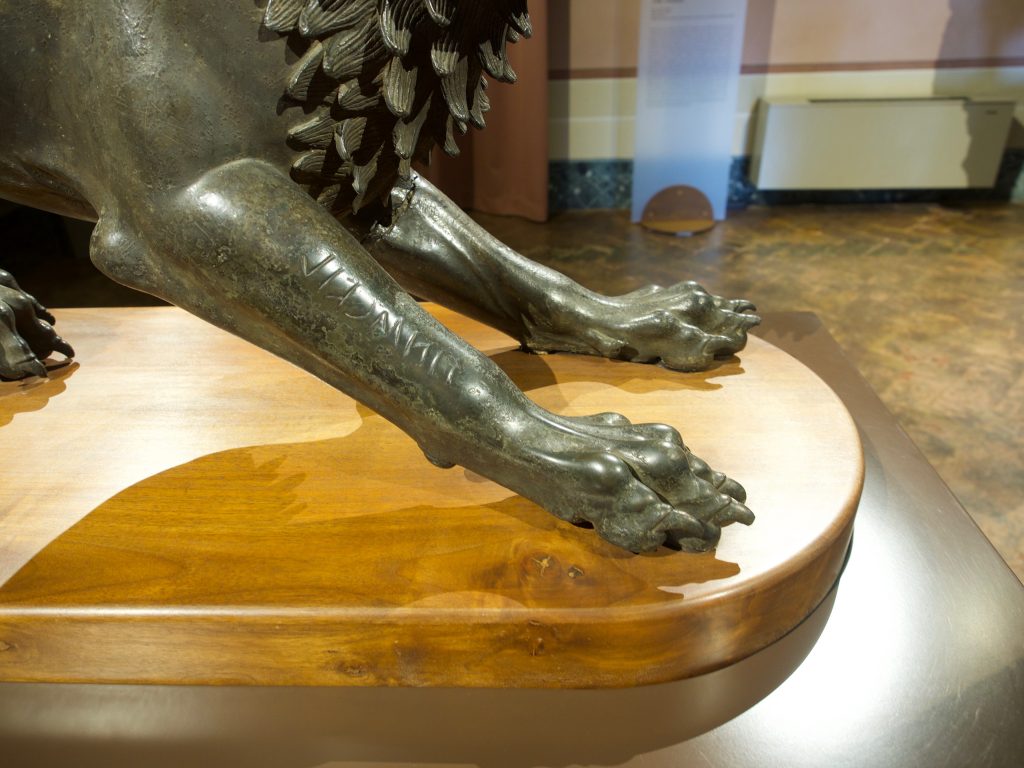
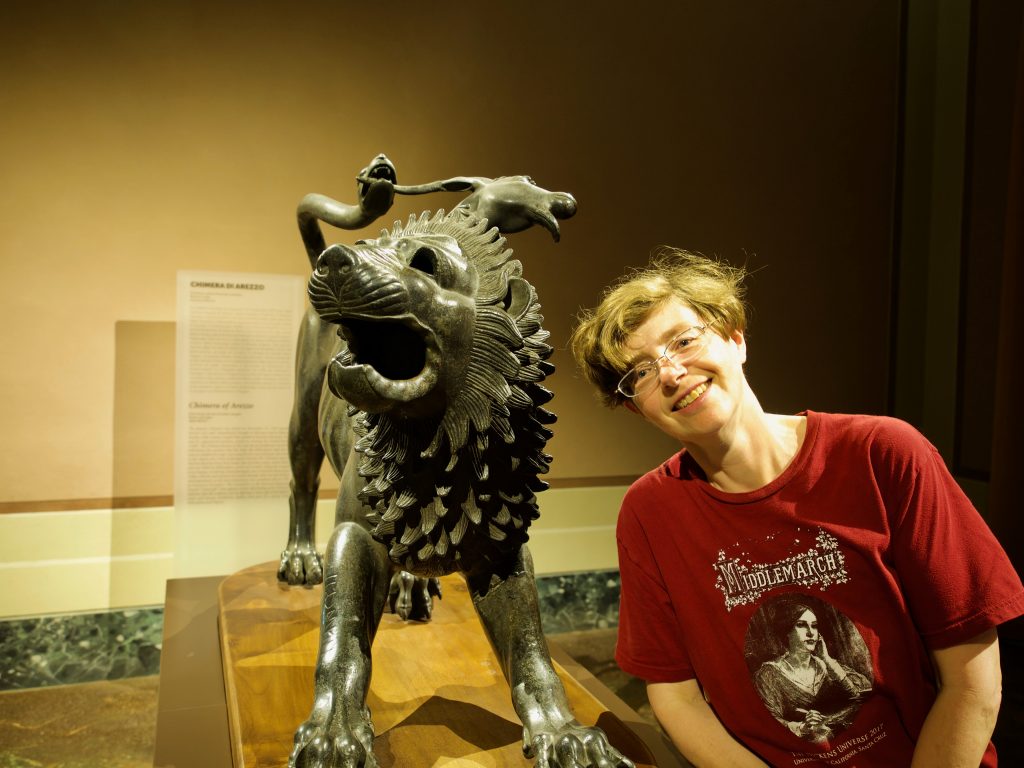
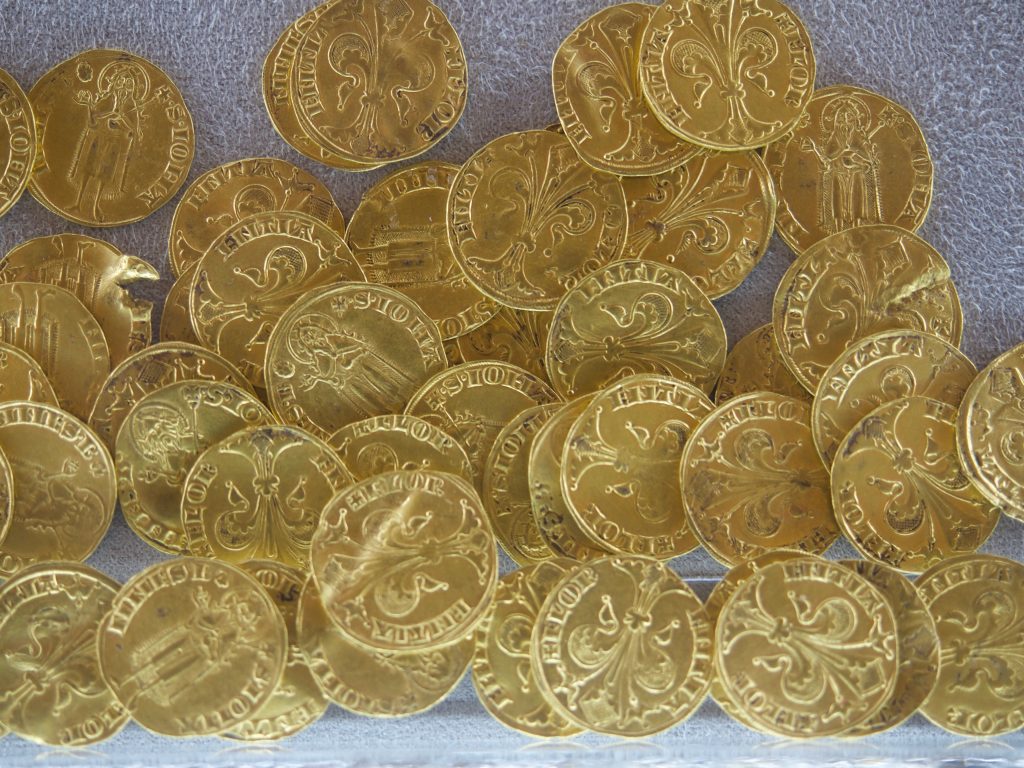
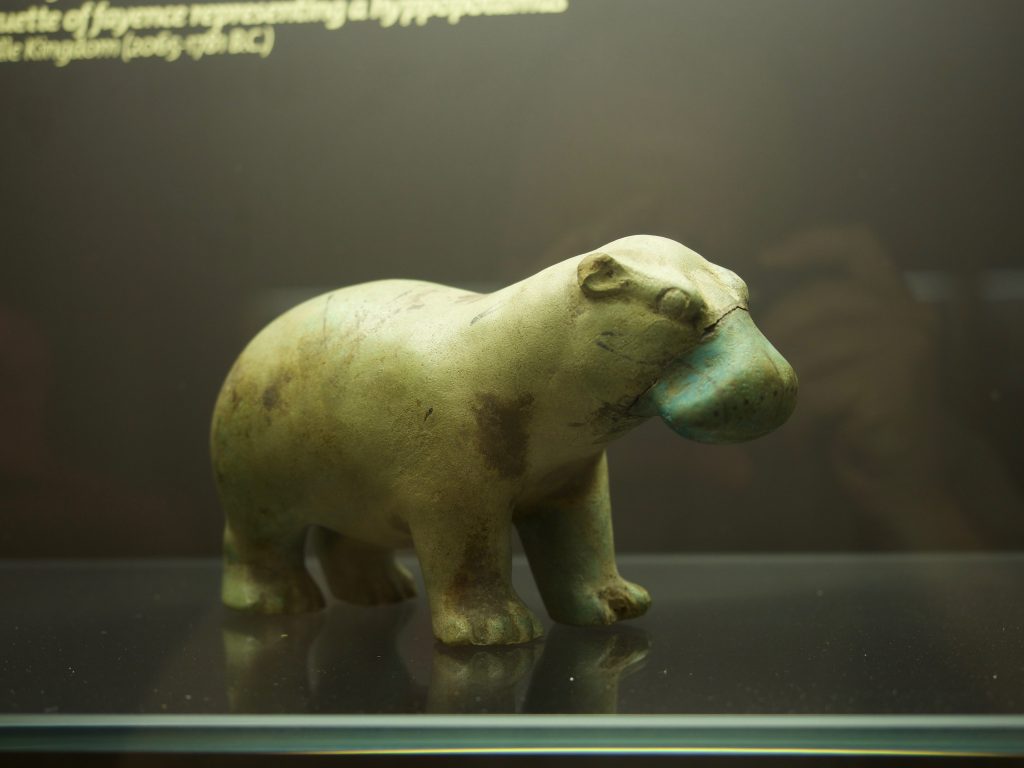
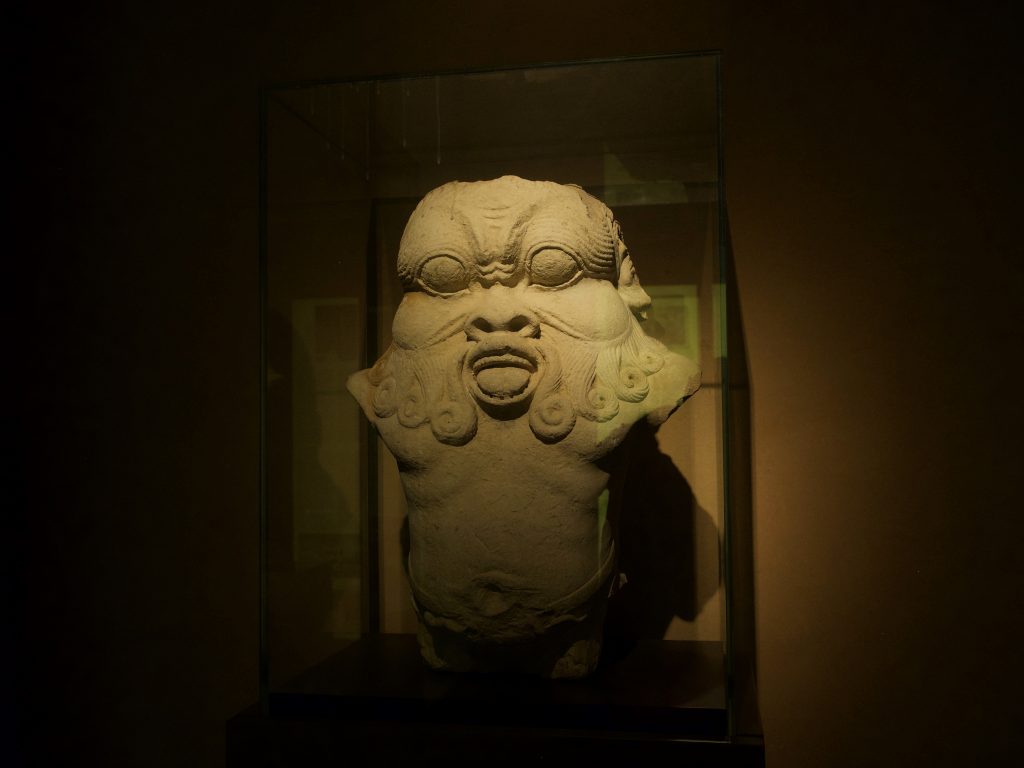
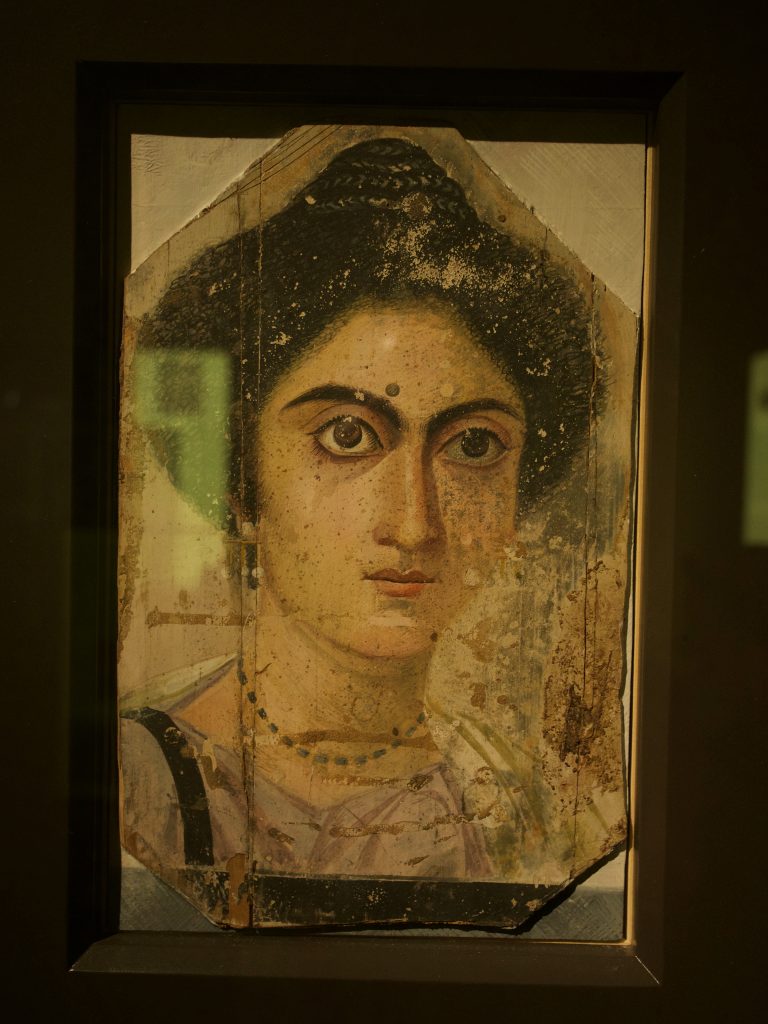
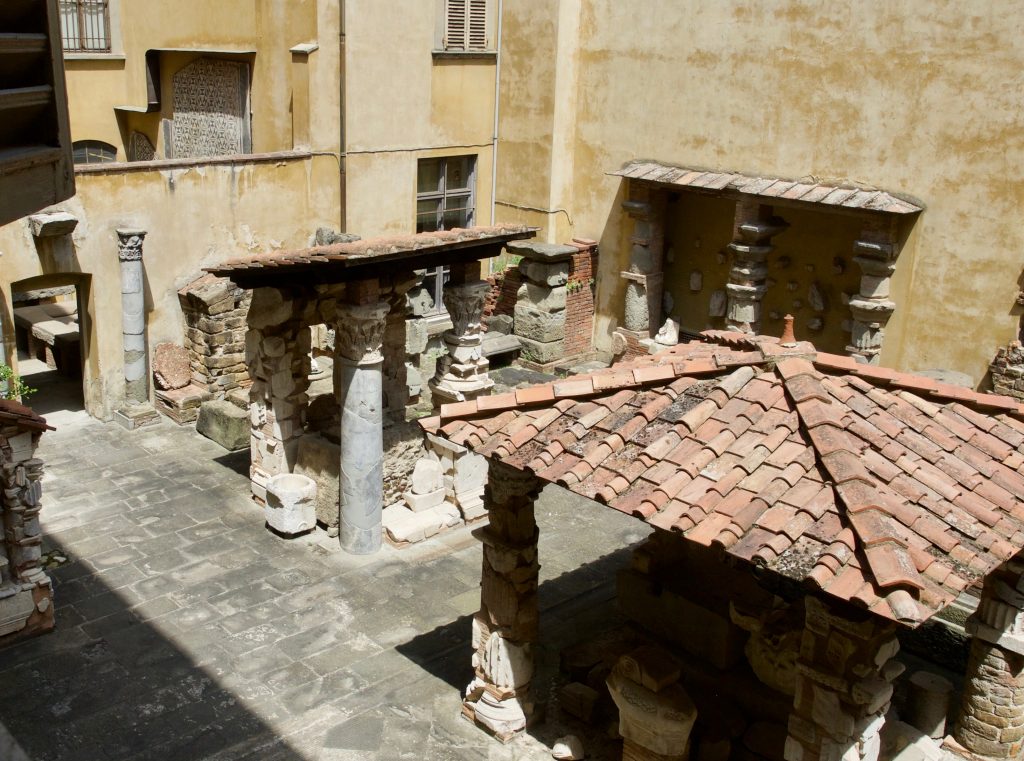
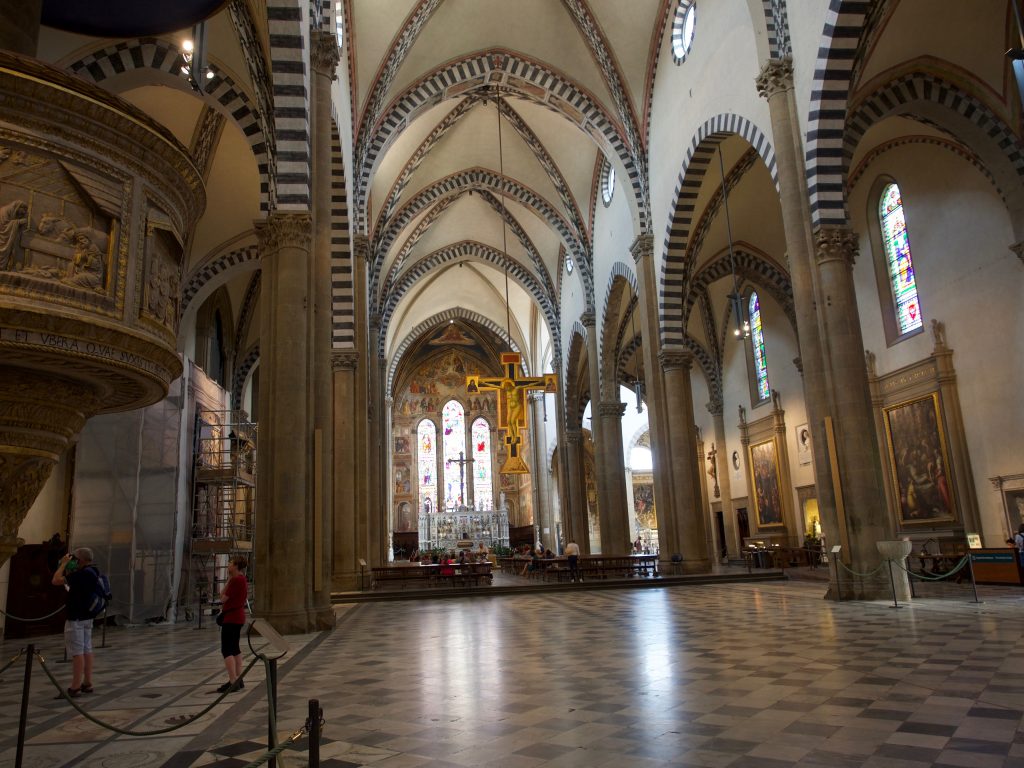
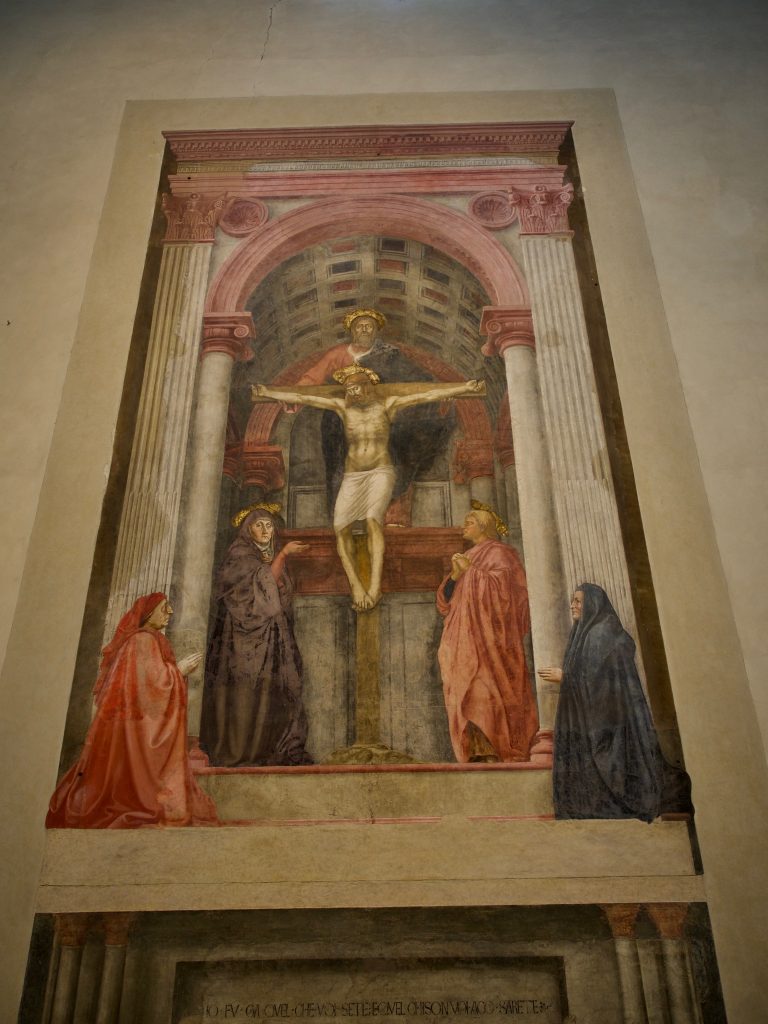
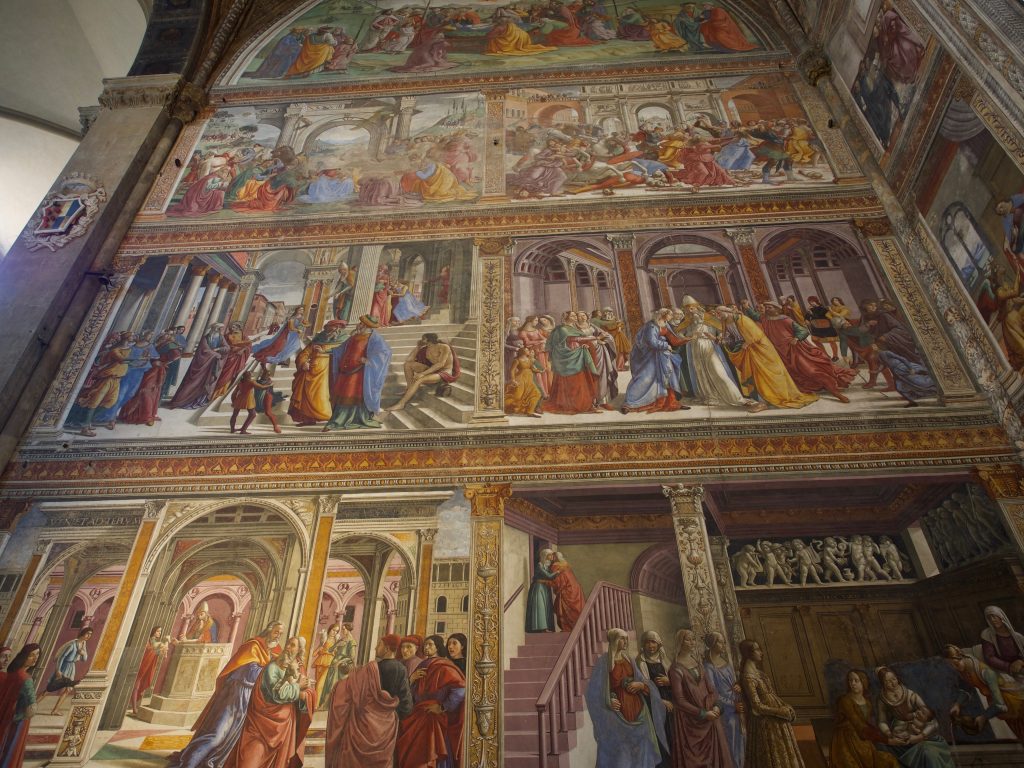
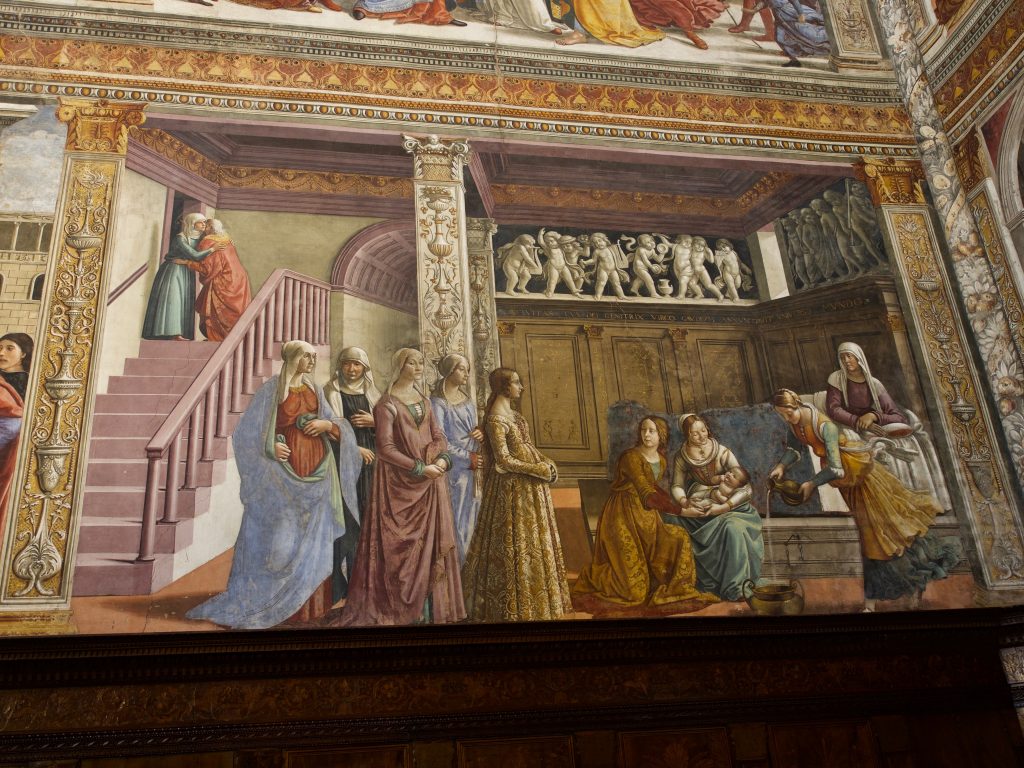
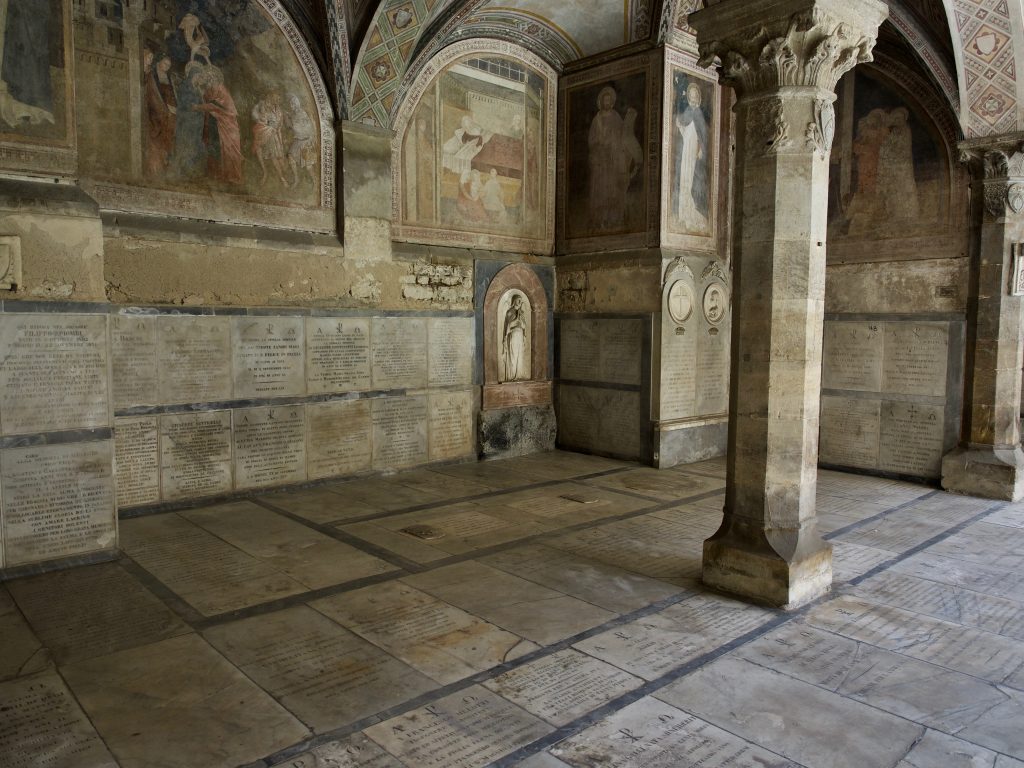
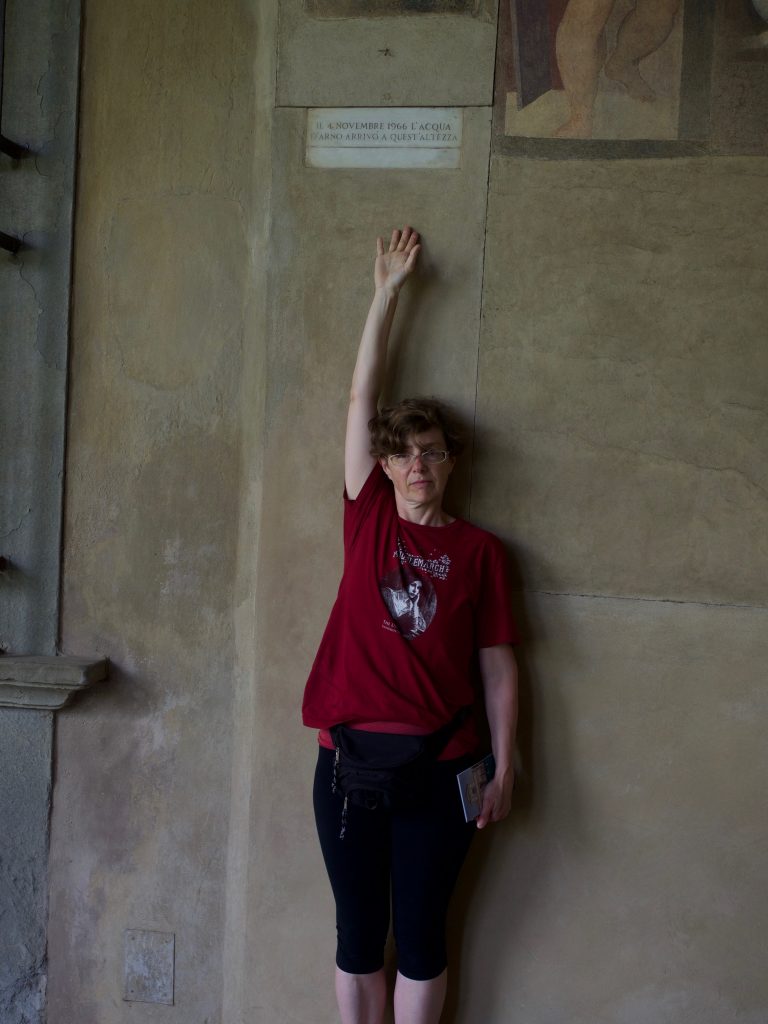
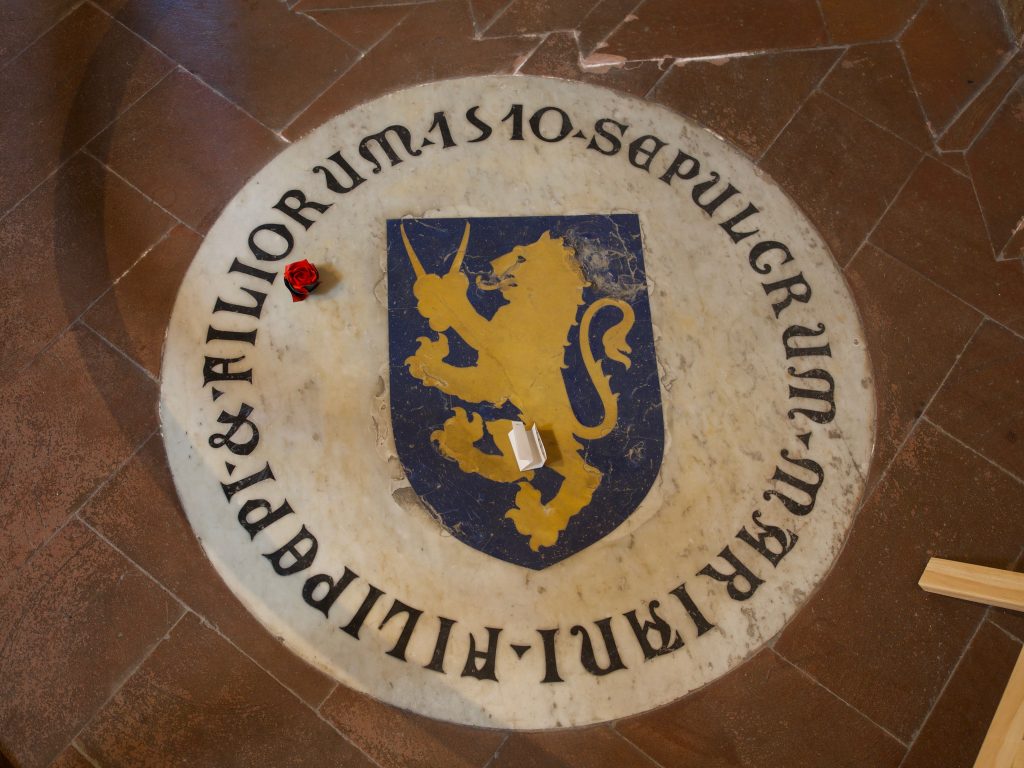
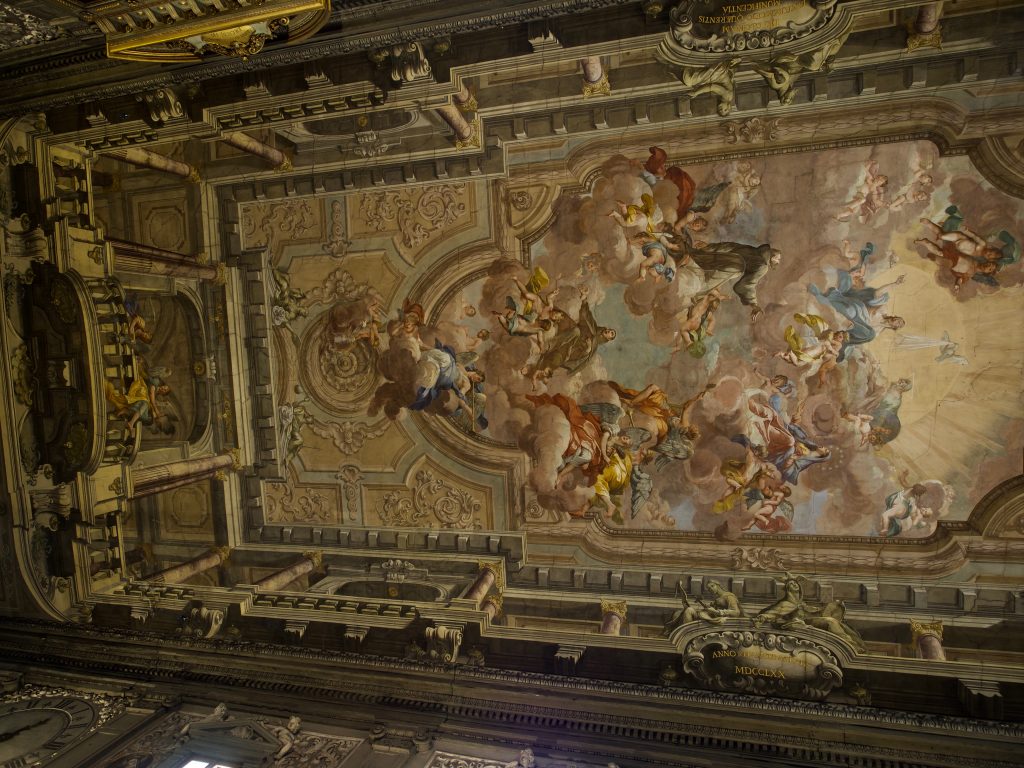
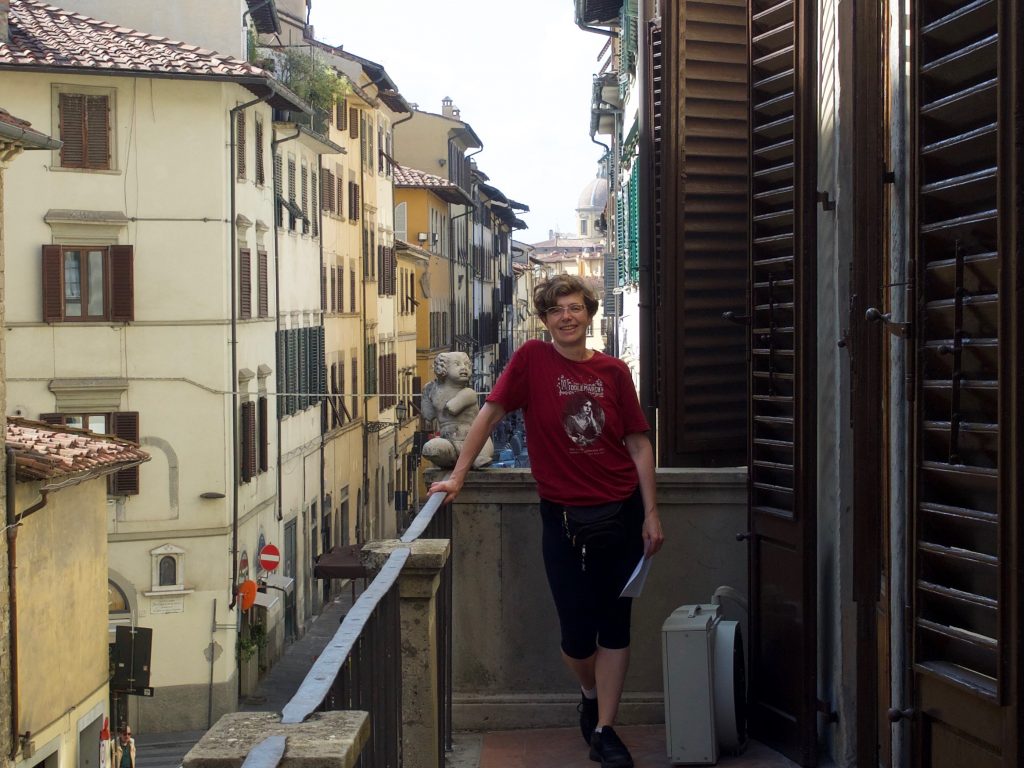
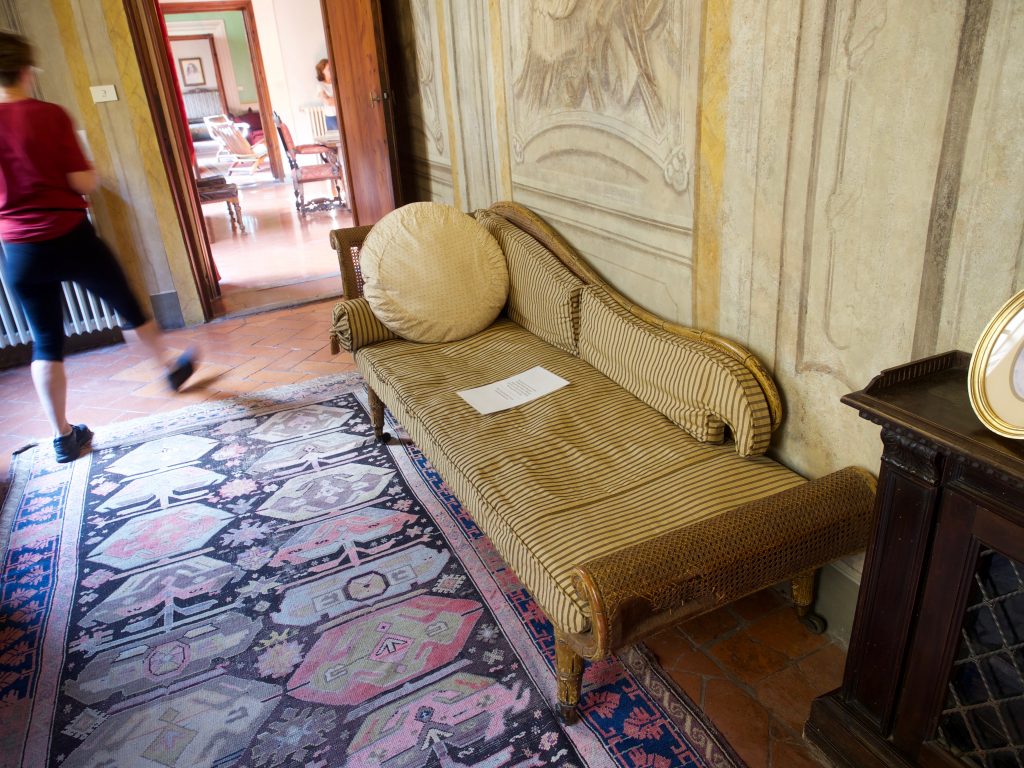
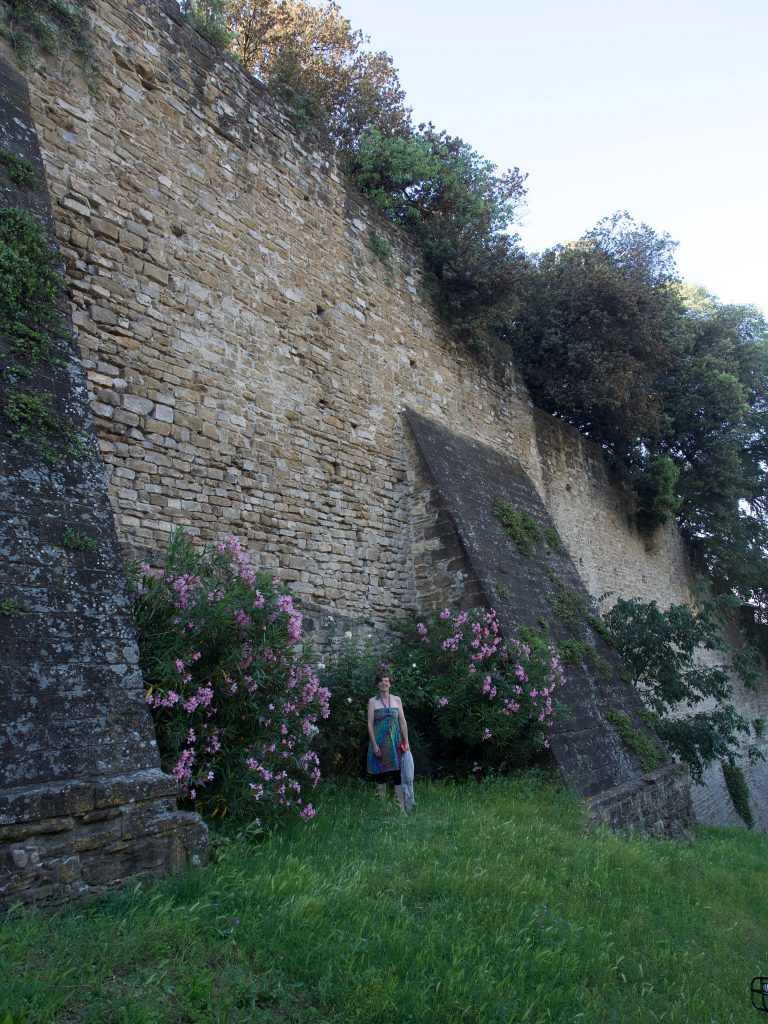
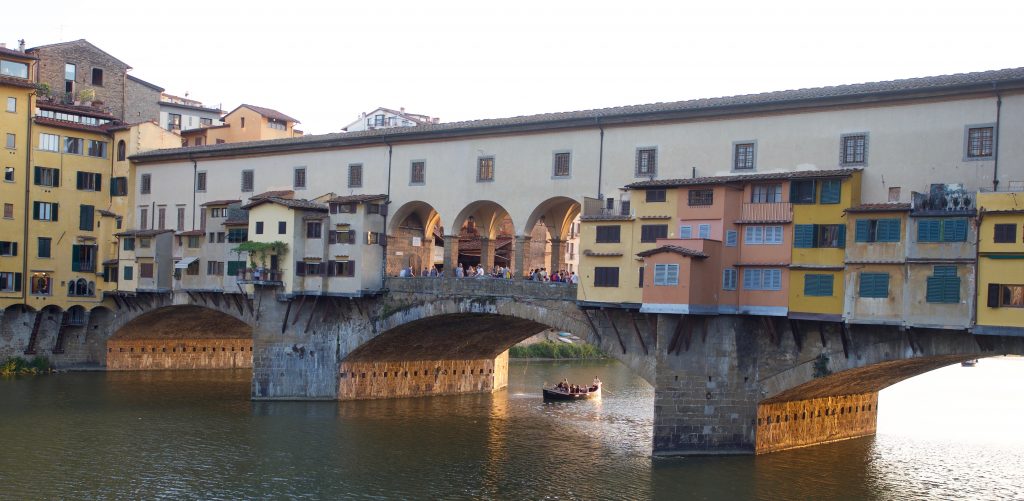
We began and ended the day with something that didn’t quite work out, but some of that that CAN be fixed in the last couple of days we have here—because of strange hours, we had to postpone a trip to the Protestant Cemetery, where lots of Victorian expats from England are buried, and my much-anticipated trip to S. Maria del Carmine and the Brancacci Chapel. And we found out that we have to completely forego a couple of other things that are simply not going to be open at the right time, including the Horne collection and the garden of the archeological museum. But otherwise, we had a great last “FirenzeCard” day with more museum and church visits.
We began by a walk across the St. Ambrogio market (a real market & flea market for real people, rather than for tourists) and the city gate directly to the East of it (unspectacular). After a useless detour to the Protestant Cemetery (open 3-6 pm only) and wanderinb by a few other things on the East side of the old town, we finally did make our first real stop at the Spedale degli Innocenti, the Foundling hospital, which took in unwanted babies from the 15th to the 19th centuries. Famous for its beautiful design by Brunelleschi and for its medallions in ceramics by Lucca della Robbia, it’s been recently remodeled and is now a somewhat spare but really modern museum, with a handful of major paintings, including their prize Ghirlandaio, an Adoration of the Magi with a self-portrait, but also a large Piero di Cosimo Madonna Enthroned with Saints, so that I finally got to see one of his large religious pieces in person. We especially enjoyed the cafe at the top with its fairly close view of the cupola of the duomo with just roofs around us; a bit pricey but very quiet.
We then spent a couple of riveting hours at the archeological museum, which blew us completely out of the water—we spent almost 3 hours there. First of all, we found out that one could only go up to the third floor at designated times, and so we went up there first, together with another American couple, who were rather excited about SOMETHING. When I found out from talking to them what they were excited about, I immediately got it: They had come to see the François Vase, a really famous huge early Greek vase, in many pieces, from an Etruscan room. Turned out that she was a professor of art history from a small liberal arts college near DC, specializing in Mesopotamian art, but like me teaching everything under the sun, so she was very excited to see it. So was I, and some of the details were really mindboggling, like an Artemis as ruler over the animals on one of the handles, but what was even more exciting were several large Etruscan bronzes, including a beautiful figure called “The Little Idol, the late Arringatore (or Orator) with distinctly Roman features, a famous head of a youth, and especially the chimera/lion of Arezzo, which my friend Chris had told me to visit for him. There were no alarms or cases for these bronzes, so I had an incredibly close look! We looked at a lot of other finds from Etruscan tombs, which are mind-boggling—especially, as in the Vatican, the many black- and red-figure vases, and even a beautiful Archaic kouros or youth. But then, beyond the Etruscan section, there was MORE. There was an entire Egyptian collection that was still very 19th century but as impressive as, say, the one on Berlin’s Museum Island, with papyri, sarcophagi, mummies, wall frescoes, statues, and the works—Mark’s favorite was a funky-looking stone god, Bes, and mine was a gorgeous, individualized and well-preserved Coptic icon painting from inside a sarcophagus (4th c ad) that looked like Frieda Kahlo. There was a courtyard full of antique debris—basically an outdoor shed for what they couldn’t display—as well as some Roman art. But then there was also the Medici gemstone collection, newly displayed (as of 2018) inside a reconstructed 17th-century Medici walkway from this building to next-door SS Annunziata, from when this was the Palazzo Crocetto and a sister of Cosimo III lived here. It was probably 100-150 feet long and had beautiful display cases with good documentation for both cameos and intaglios, which were backlit and accompanied by a positive. I read that there were 432 different pieces on display, almost all Hellenistic or Roman (Republican to late Imperial), although many in Renaissance mounds with gold and jewels. Two favorites were Hercules Peeing, which was actually either Roman Republic or a 15th century “fake,” and, especially for me, an Ariadne and Dionysos from the 1st/2nd c AD with a 16th-century mound. Then there was a coin collection with gold hoards from Florence as well as ancient Rome and Greece—some of them pea sized coins like we had never seen before.
After this impressive museum, we badly needed lunch, but had to walk around a bit until we found something to our liking—a little street cafe with a daily menu—I had gnocchi with zucchini cream and Mark had pasta with tomato sauce, with bubbly water, for a total of 16 euro including service charge, so that was very nice after our expensive coffee and pastry in the morning. Then, we headed to the west side of town and toured Santa Maria Novella. I really like the old black-and-white “chessboard” churches, and this one was no exception—and apparently of all the Gothic churches, it’s the most important one in Tuscany (says the Blue Guide). It has a beautiful facade (Alberti) and the classic stripy gothic arches inside. But inside, there is also the Holy Trinity by Masaccio with its amazing spatial use of linear perspective, and a big crucifix by Giotto. The side chapels had lots of frescoes in varying states of restoration and decay, with the Filippino Lippi chapel probably in best shape, apart from the freshly restored enormous four-story Ghirlandaio frescoes surrounding the (19th-century) altar. I had admired this in the textbooks before, but the size was pretty overwhelming, with the beautiful birth of the virgin in a Tuscan palazzo on the bottom right of the left-hand wall, and the many built-in portraits and the lowest level (presumably so that the portrayed could admire themselves?). Unfortunately, the famous giraffe was too far up to get a good shot, and I was a little upset that we couldn’t see it better.
Apart from the church itself, there is the Spanish chapel (former chapter hall), which had arresting art by a fresco painter I had never heard of (Andrea di Bonaiuto), and more frescoes in the two big cloisters outside. Many showed the impact of time and the 1966 flood really well (there was actually a floor room marker in the cloister where the flood had reached to at this church, which is fairly close to the river). But the cloisters were again very beautiful and full of grave plates moved from the floor to the walls. Then we went to the church of the Ognissanti, one of those baroqued-up 13th-century churches, where we saw the grave plates for Botticelli and for amerigo Vespucci. This church was trying a little hard for the tourist, with very lit up crucifix (again by Giotto) and Gregorian chants from the sound system. But it did have a rococo illustionistic ceiling complete with trompe l’oeuil balconies that was kind of fun. The “cafeteria”/cenacolo with a Last Supper by Ghirlandaio wasn’t open at this time, but at least I knew that. What I didn’t remember was that we had to be at the next church, S. Maria del Carmine, before 4 pm to be let in, even though it was open until 5 pm. We showed up at 4:30 to closed doors, and I was very upset—we’ll be back Friday, but then we’ll have to actually pay extra for tickets. Meh.
Our last stop for the day was really small, but also cute—the apartment at Casa Guidi where Elizabeth Barrett Browning, Robert Browning and their son Pen lived from 1847 until EBB died in 1861. Pen later bought the building and slowly but surely funds were raised to restore the rooms to look like they did when the Brownings lived there, with as many original pieces as had been in Pen’s possession, including a couple of family paintings. I am not really a big enough super fan (although I love EBB’s poetry, and some of RB’s too) to be worthy, but I stood on ebb’s balcony and admired the sofa from which she first greeted Browning in London. It was a very sweet ending to the day. The apartment is open for visitors 3x a week from 3–6, but EBB fans must be getting rare. According to the guest book that I signed, we were the first visitors for the day.
We then went back to the apartment, with the usual grocery stop. After another dinner of pasta (carbonara) and salad that I was fairly proud of, we took a little walk, meaning to explore the nearby Fort Belvedere, but that was closed. So we walked to the San Niccolò tower, then to the Palazzo Vecchio to people watch, and lastly back across the Ponte Vecchio to make sure the sun went down with us watching. Then home and off to bed!